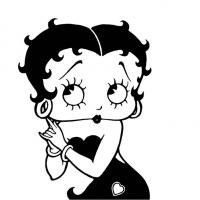
Betty Boop
CBUB Wins: 0
CBUB Losses: 1
CBUB Ties: 0
Win Percentage: 0%
Added by: patrickthekid
Read more about Betty Boop at: Wikipedia
Official Site: Max Fleischer
Betty Boop is an animated cartoon character created by Max Fleischer with contributions from animator Grim Natwick among others. She originally appeared in the Talkartoon and Betty Boop series of films which were produced by Fleischer Studios and released by Paramount Pictures. She has also been featured in comic strips and mass merchandising. With her overt sexual appeal, Betty was a hit with film-goers, and despite having been toned down in the mid-1930s to appear more demure, she became one of best known cartoon characters in the world and remains popular today.
Betty Boop made her first appearance August 9, 1930 in the cartoon Dizzy Dishes, the sixth installment in Fleischer's Talkartoon series. The character was modeled on superstar actress Clara Bow, the It-girl whose sweet and seductive baby-doll looks was a well established marquee at the time. Bow kept her grip on her audience through the transition to sound, 1928/1929, and her muted but characteristic Brooklyn accent, singer Helen Kane, effectively caricatured. Also the choice of name for the cartoon, is built on Clara Bow's three syllable name. Betty Boop was originally created in the mode of an anthropomorphic French poodle.
Betty's voice was first performed by Margie Hines, and was later provided by several different voice actresses including Kate Wright, Ann Rothschild (aka Little Ann Little), Bonnie Poe and most notably, Mae Questel, who began in 1931 and continued with the role until her death in 1998. Today Betty is voiced by Tress MacNeille and Tara Strong in commercials.
Although it has been assumed that Betty's first name was established in the 1931 Screen Songs cartoon Betty Co-ed, this "Betty" was an entirely different character. Though the song may have led to Betty's eventual christening, any references to Betty Co-ed as a Betty Boop vehicle are incorrect. (The official Betty Boop website describes the titular character as a "prototype" of Betty.) In all, there were at least 12 Screen Songs cartoons that featured either Betty Boop or a similar character. Betty appeared in the first "Color Classic" cartoon Poor Cinderella, her only theatrical color appearance (1934). In this film, she was depicted with red hair. In a cameo appearance in the feature film Who Framed Roger Rabbit (1988), in her traditional black and white, and voiced by Mae Questel, Betty mentioned that work had "gotten slow since cartoons went to color," but she has "still got it, boop oop a doop boop!"
CBUB Match Record:
| Result | Opponent | My Score | Their Score | |
|---|---|---|---|---|
| Loss | Clayton (Disney) | 4 | to | 16 |
No Fantasy Draft Records Available
